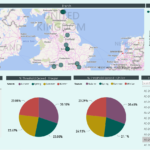In today’s fast-paced world, everybody wants to adopt rapidly growing technology to optimize their business operations. Microsoft Power BI based business intelligence solutions enable the customer’s supply chain and operating team to manage their food delivery operations seamlessly. The interactive and innovative BI supply chain dashboards unlock critical business insights on temperature threshold, driver performance, as well as customer behavior to support customers to make smart decisions. Additionally, supply chain management is a field where the retailers and food provider businesses are leveraging the benefits of this technology in their day to day supply chain operations. Moreover, since we all are aware, the supply chain management is a complicated business to deal with and the lack of synchronization or even one missing entity in the entire process can cause the disturbance in the supply chain, causing the businesses to face losses in millions or maybe in billions.
Whereas in a market where the businesses and organizations are continuously aiming towards cutting the costs, profit increment, and improving customer experience at every stage, technologies like Artificial Intelligence, Machine Learning are offering numerous opportunities to the supply chain management companies.
How Business Intelligence Solutions Change the Supply Chain?
1. Tackling Disruptions
2. Better Visibility Into Data
3. Brings Real-Time Visibility To Improve Customer Experience
4. Effective Supply Chain Management
5. Smart Decision Making
6. Excellent Return On Investment
7. Provides Intuitive Dashboard
1. Tackling Disruptions
The power of BI in the supply chain can easily combat food spoilage. By unleashing the power of historical and real-time data, it helps businesses in making better decisions. As we all know, supply chain disruptions pose a significant threat to businesses and supply chain organizations, regardless of the size of the company. The main reason for disruptions could be the weather conditions, cyber-attacks, or geopolitical actions.
And these kinds of unforeseen factors could have a massive impact on the cost of goods, deliveries of the goods, and a negative impact on the well-prepared budget of the organizations. Power BI helps businesses to broaden their supplier network. So, identifying the suppliers in different geolocations would help companies to monitor the news to be prepared for impending disruptions from forces of nature, culture, or politics, and even if the storm makes the railway tracks or roads impassable, they could easily fund another route.
2. Better Visibility Into Data
Power BI in supply chain management enables companies to have better visibility of data. The companies can have a clear picture of on-time delivery and asset utilization to make better decisions and anticipate risk. Further, the companies can have insights into the costs and profits, within the supply chain, as it enables the managers to allocate the resources and to have the knowledge of the areas where improvement is needed. The companies and businesses can have a real-time picture of what’s happening throughout their supply chain operations. And not only this, but they can also quickly analyze data from multiple sources feeds and can have a bigger picture of that top. Power BI is integrated with powerful tools and services that allow businesses and organizations to have a deep understanding and knowledge of data analytics and visualization. However, the power BI supports a wide range of Flat files, Databases, OData Feed, bank query, cloud platform, and other services Hadoop, etc.
The power BI also provides the most valuable feature that is quick insights that allow the user to search for datasets or dashboards for more interesting insights within seconds.
3. Brings Real-Time Visibility To Improve Customer Experience
Customer experience is one of the most critical factors driving profitable growth. Providing real-time visibility to the customers to improve the end-user experience is a significant organizational challenge for many supply chain professionals today. The word visibility has been buzzing around the supply chain circle for many years now, and many businesses and supply chain organizations have promised to improve visibility in some or the other way. There’s an interesting fact. The technologies like IoT, real-time analytics are helping to enhance the visibility in the supply chain. Furthermore, we can witness that even machine learning is contributing as well in improving customer experience in the food supply chain. Machine learning is capable of discovering some complex interconnections between various processes by examining their historical data.
Amazon is the best example of it has been leveraging the benefit of machine learning as it’s improving its end-user experience, by a thorough understanding of how the customers get influenced by market product recommendations. Through Power BI, we can analyze the consumers’ buying trends; this helps the organizations and businesses to develop a product according to their trends.
4. Effective Supply Chain Management
Customer satisfaction is a priority, as mentioned above. And it’s highly dependent on the adequate supply chain; the businesses should be able to manage their supply chain, keeping that in mind. Power BI helps to carry out effective and efficient supply chain operations. Here we can witness BI in supply chain management is more than just a technology. Although, supply chain being a very complicated business, its networks need to be managed actively and optimized globally. Moreover, the business landscape keeps on changing with increasing competition and growing demands of the customer.
However, to be competitive, companies are utilizing business intelligence technologies to manage their businesses better and anticipate the future. Furthermore, performance management (PM), in collaboration with BI, links people, business strategies, processes, and technology. The PM system is a platform to improve supply chain operations. And when it comes to supply chain management, functions, business intelligence is of utmost importance more than ever today.
5. Smart Decision Making
The power BI helps supply chain businesses in making informed decisions based on strategic issues taking place. Power BI is providing all the vital data based on the present and historical performance of the company with the future demand, trends, consumer behavior, and their expectations. Reports based on accurate and timely information enables companies and organizations to measure their business operations and day to day activities. BI also allows companies to find out the best and worst-performing KPIs. The day to day reports and analytics help food provider companies and supply chain management companies to keep track of the performance and look for areas of improvement. Users can easily keep track of the information and can set the goals accordingly.
6. Excellent Return On Investment
Profitable revenues are, indeed, a sign of success and Microsoft Power BI boosts ROI. It provides a clear picture of better strategic plans, faster reporting. It lowers the cost/overheads, increases revenues as well. Power BI in supply chain management helps in improving business efficiencies and processes, employee productivity, and customer satisfaction. Microsoft Power BI is a vital data visualization tool. BI helps the employees to focus on productive and creative tasks to help them grow the business.
The power BI solutions in supply chain management can be a significant game-changer. Power BI boosts the management system or ERP without the need to change it, that too, with the help of seamless integration. It not only facilitates the creation of customized applications, but also helps the users to solve specific complex processes, routine tasks, and business needs. Lastly, it has automated business processes by significantly increasing business productivity.
7. Provides Intuitive Dashboard
The managers who want to have a quick overview of their entire supply chain networks or their transportation activities use the dashboards which provide them with real-time information. Look for- and solve problems whenever they occur. The real-time dashboards make it easy for the supply chain management companies to find out the on-going trends, customer expectations, analyze the components of their transportation activities and day to day operations. These dashboards provide the benefit of quick reaction time. This means the dashboards keep updating as the business is taking place; the supply chain managers don’t have to wait for any person to send the reports and analytics. Therefore, making them take actions and react faster to the changes in the market. Furthermore, users can easily find out the tender rejections occurring within the lane, so that they can rebid lane then and there.
Conclusion
Business intelligence in the supply chain helps to enhance the internal efficiencies and productivity, as well as accountability, saves time, reduces costs, helps in decision making. The companies can easily predict their business performances by putting the right and useful information and detailed reporting in the hands of decision-makers. Apart from this, it’s not always an easy task for manufacturers and distributors to maintain a healthy supply chain. But some tools offer new opportunities for greater control.
By: Matellio






